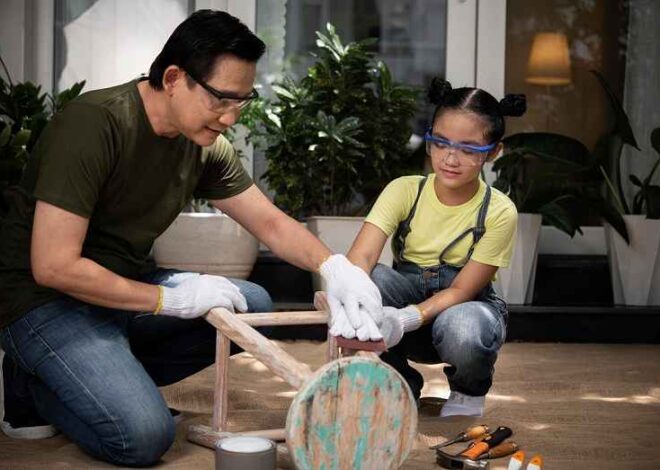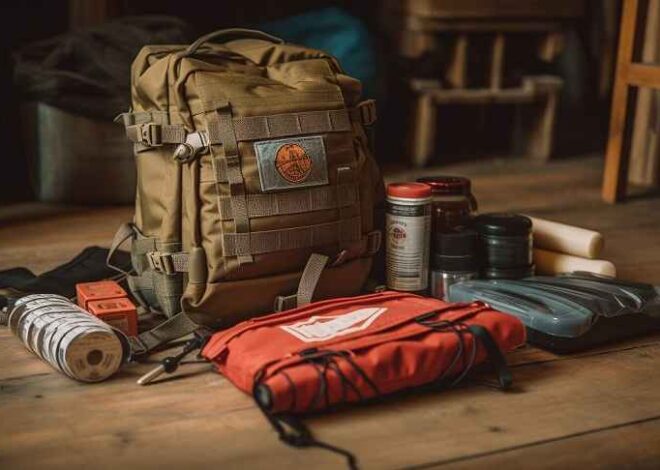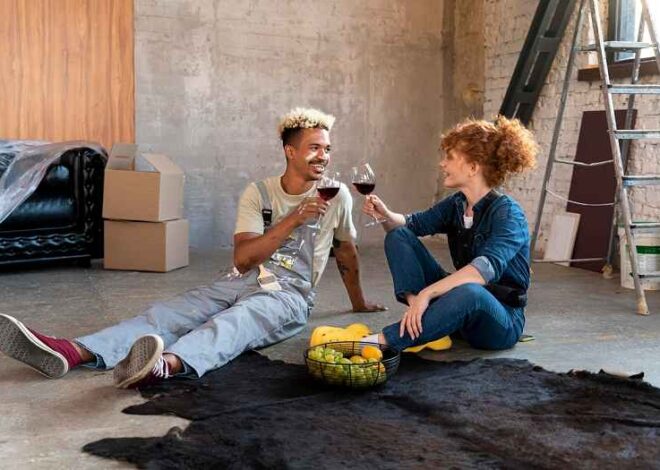
Safe Home Decorating: Creating Beautiful and Secure Spaces
Welcome to the world of home decor, where creativity knows no bounds and every corner is an opportunity for self-expression! But before you dive headfirst into that Pinterest-inspired dream space filled with vibrant colors and chic accents, there’s one crucial aspect that deserves your utmost attention: safety. In our quest to curate beautiful environments, it’s easy to overlook potential hazards lurking within our design choices. From selecting kid-friendly fabrics to ensuring proper lighting and securing heavy furniture, prioritizing safety doesn’t mean compromising on style. Join us as we explore how to harmoniously blend aesthetics with practicality, transforming your home into not just a visual delight but also a safe haven for all who enter.
Introduction: Importance of Safety in Home Decor
Creating a beautiful space in your home is more than just aesthetics; it’s about ensuring that your sanctuary is safe for everyone who lives there. Imagine walking into a room filled with vibrant colors and stylish decor, only to be met with hidden dangers lurking around the corner. That’s why prioritizing safety alongside style is essential in home decorating.
Every choice you make—from the furniture you select to the accessories you hang on walls—can impact not just how your home looks but also how secure it feels. Whether you’re sprucing up your living space or transforming an entire room, understanding common household hazards can help prevent accidents before they occur. Let’s dive into what safe home decorating truly means and explore practical tips to keep your environment both inviting and secure.
Understanding Common Household Hazards
Your home should be a sanctuary, but it can also hide some common hazards. Identifying these risks is the first step to safe home decorating.
Tripping hazards are often overlooked. Cluttered pathways or loose rugs can lead to falls, especially in high-traffic areas like hallways and living rooms.
Fire hazards are another concern. Decorative items like candles and fairy lights add charm but need careful placement. Ensure they’re not near flammable materials such as curtains or upholstered furniture.
Chemical hazards lurk in many household products too. Paints, cleaners, and adhesives may contain harmful substances that pose health risks if used improperly or stored carelessly.
Recognizing these dangers helps create a safer environment while you express your style through decor choices. Being mindful of potential issues fosters peace of mind in your beautifully designed space.
-
Tripping hazards
Tripping hazards can turn your beautiful home into a risk zone. One of the most common culprits is clutter. Shoes, bags, and toys left in walkways might look harmless but can lead to serious accidents.
Rugs also deserve attention. A decorative rug that isn’t secured properly can slip or bunch up, causing unexpected tumbles. Consider using non-slip pads underneath to keep them in place.
Wires from electronics often snake across floors unnoticed. Tucking cords behind furniture or using cord management solutions helps eliminate this hazard.
Stairs need special care too. Ensure they’re well-lit and free of obstacles. Adding handrails provides extra support for anyone navigating those steps.
By keeping these areas clear and organized, you enhance both safety and aesthetics in your space, allowing everyone to enjoy the beauty while remaining injury-free.
-
Fire hazards
Fire hazards in the home can often go unnoticed until it’s too late. One of the most common threats comes from overloaded electrical outlets. Using too many devices on a single outlet increases the risk of shorts and sparks.
Another area to consider is kitchen safety. Keep flammable items, like dish towels and paper products, away from stove tops and ovens. Regularly check your cooking appliances for wear or damage as well.
Candles add warmth to any space but can also pose significant risks if left unattended. Always extinguish them before leaving a room, and opt for flameless alternatives when possible.
Lastly, ensure that smoke detectors are installed in every room and test them regularly. A simple action like changing batteries can make all the difference in protecting your home from fire hazards.
-
Chemical hazards
Chemical hazards in home decor can often go unnoticed. Many common household items contain volatile organic compounds (VOCs) that release harmful fumes into the air. Paints, varnishes, and even some furniture emit these toxins.
Cleaning products are another significant concern. The strong chemicals in many cleaning supplies can cause respiratory issues or skin irritations. Opting for natural alternatives not only helps your health but also contributes to a safer environment.
Furniture finishes may also pose risks. Some treatments and coatings use chemicals that aren’t safe for indoor use, especially without proper ventilation.
Be mindful of adhesives as well; they can release harmful vapors long after application. Always check labels and choose non-toxic options whenever possible. Taking these steps ensures a beautiful space that prioritizes safety alongside style.
Tips for Safe Home Decorating:
When it comes to safe home decorating, the materials you choose play a crucial role. Opt for non-toxic paints and finishes that are low in volatile organic compounds (VOCs). This helps improve air quality while keeping your space beautiful.
Furniture placement is another essential factor. Ensure paths are clear from clutter to minimize tripping hazards. Arrange seating and tables so they don’t obstruct walkways, especially in high-traffic areas.
Don’t forget about securing decorations. Use wall anchors for heavier items like mirrors or framed art. This prevents accidents from falls and maintains the integrity of your decor style.
Lastly, take care with accessories such as candles or string lights. Always follow manufacturer guidelines for installation and maintenance to reduce fire risks while enjoying an inviting ambiance in your home.
-
Choosing Non-Toxic Materials
When it comes to home decor, the materials you choose can significantly impact your family’s health. Opting for non-toxic materials is essential, especially in spaces where kids and pets roam freely.
Look for paints and finishes that are labeled low-VOC or VOC-free. These options minimize harmful emissions while still providing vibrant colors.
Selecting natural fabrics like organic cotton, linen, or hemp can enhance comfort without compromising safety. They not only feel great but also reduce exposure to harmful chemicals often found in conventional textiles.
Furniture made from solid wood rather than particleboard ensures a healthier indoor environment too. Particleboard often contains formaldehyde adhesives that can off-gas into your home over time.
By prioritizing non-toxic choices, you create a beautiful space that’s as safe as it is stylish. It’s about finding elegance without sacrificing well-being.
-
Proper Furniture Placement
Proper furniture placement is crucial for both aesthetics and safety. Begin by assessing the flow of your space. Ensure pathways are clear, allowing easy movement throughout your home.
Consider the size of your furniture in relation to the room. Oversized pieces can create a cramped environment, while smaller items might get lost in expansive areas. Balance is key.
Avoid placing heavy items near stairways or entrances where they could obstruct escape routes during emergencies. It’s also smart to keep frequently used pieces within reach, minimizing unnecessary strain when accessing them.
Think about visibility too—arranging seating to encourage conversation can enhance social interactions while maintaining safety with unobstructed sightlines around potential hazards like fireplaces or glass tables.
Lastly, anchor larger furniture against walls whenever possible. This not only stabilizes them but also prevents tipping accidents that could pose risks to family members and guests alike.
-
Securely Mounting Decorations and Accessories
When it comes to decorating, securing your items is key. Loose decorations can pose a danger, especially in homes with children or pets. Wall art, shelves, and heavy accessories should be properly anchored.
Use wall anchors for heavier pieces such as mirrors or large frames. This ensures they won’t fall over during an unexpected event like a tremor or if someone bumps into them.
For shelves, opt for sturdy brackets that can handle weight without bending or breaking. It’s not just about aesthetics; it’s about peace of mind.
With smaller decor items, consider adhesives designed for safety. These products keep lighter objects from sliding off surfaces while adding charm to your space.
Remember to regularly check the stability of mounted décor. Over time, wear and tear can compromise their integrity. A simple inspection goes a long way in maintaining both beauty and safety in your home.
Childproofing for Families with Young Children:
Creating a safe home for young children involves thoughtful planning. Start by covering electrical outlets with safety plugs. Curious little hands can easily reach these hazards, so keeping them secure is essential.
Cordless window treatments are another smart choice. Long cords can pose strangulation risks, while cordless options provide both safety and style.
Don’t forget kitchen cabinets! Installing locks on drawers and cupboards keeps harmful items out of reach. Children often explore their surroundings, making it crucial to lock away cleaning supplies or sharp utensils.
Consider using corner guards on furniture edges as well. This small addition can prevent nasty bumps and bruises when your child starts exploring the world upright.
Lastly, regularly check your space for any potential dangers that might have been overlooked during initial setup. The goal is a cheerful environment where kids feel free to play safely.
-
Covering Electrical Outlets
Electrical outlets can be a hidden danger, particularly in homes with young children. Curious little hands may reach for them without understanding the risks involved.
To mitigate this hazard, covering electrical outlets is essential. Outlet covers come in many styles, from simple plastic plugs to more decorative options that blend seamlessly with your decor.
Consider using sliding outlet covers that only open when you press down on them. These are user-friendly yet secure enough to keep tiny fingers at bay.
Additionally, educate older children about the importance of not tampering with outlets or cords. Setting boundaries helps create a safer environment while allowing kids some independence as they grow up.
Remember, safety doesn’t have to compromise style; finding attractive solutions is easier than ever!
-
Using Cordless Window Treatments
Cordless window treatments are a game-changer for safety and style. They eliminate the hazard of dangling cords, making them an ideal choice for homes with young children and pets.
These sleek designs offer a modern look while ensuring your space remains clutter-free. With various materials available, from sheer to blackout fabrics, you can find the perfect match for any room.
Installation is often straightforward too. Many cordless options come ready-to-hang or with easy mounting systems, allowing you to achieve that polished finish without much hassle.
Additionally, they provide excellent light control and privacy without compromising aesthetics. Enjoy the natural light filtering in without worrying about tangled cords or potential accidents.
Transitioning to cordless treatments not only enhances safety but also elevates your home’s decor effortlessly.
-
Installing Cabinet and Drawer Locks
When children explore, curiosity often leads them to places they shouldn’t go. Installing cabinet and drawer locks is a simple yet effective solution to keep their adventures safe.
These locks come in various styles, catering to different needs and aesthetics. It’s essential to choose ones that fit your cabinets seamlessly while providing maximum security.
Installation can be straightforward. Most options include adhesive backing or screws for a more permanent fix. Ensure you follow the instructions carefully for the best results.
Once installed, take time to explain boundaries with older kids. They may understand why certain areas are off-limits when given context about safety.
Remember, it’s not just about locking things away; it’s also about creating an environment where exploration happens within safe limits. Enjoy peace of mind as your little ones play freely without accessing harmful items!
Pet-Friendly Decorating:
When decorating your home with pets in mind, durability is key. Opt for fabrics that can withstand wear and tear from curious paws and playful claws. Microfiber or canvas materials are excellent choices; they resist stains and are easy to clean.
Be mindful of plants too. Some houseplants can be toxic to animals if ingested. Look for pet-safe options like spider plants or Boston ferns instead of traditional favorites like lilies or poinsettias.
Keeping cords tucked away not only helps maintain a tidy look but also prevents chewing hazards. Use cord organizers or clips to keep them out of reach.
Consider creating designated spaces for your furry friends with cozy blankets and stylish beds that blend into your decor theme. This way, you cater to their comfort while enhancing the overall aesthetic of your living space.
You may also read (using smart home devices protect your hom)
-
Choosing Durable Fabrics
When decorating your home, the choice of fabric can make a world of difference. Look for materials that not only appeal to your aesthetic but also stand up to daily wear and tear. Durable fabrics are crucial in homes with kids or pets.
Consider options like microfiber, denim, or canvas. These materials resist spills and stains while maintaining their look over time. They offer a great blend of comfort and toughness.
Test textures before committing. Some might feel soft initially but could show signs of aging quickly.
Additionally, think about colors and patterns that can camouflage minor blemishes—this will help keep your space looking fresh longer. Remember, durability doesn’t mean sacrificing style; you can achieve both with careful selection!
-
Removing Toxic Plants
When decorating your home, it’s crucial to consider the safety of all its inhabitants, including pets. Many popular houseplants can pose serious health risks to dogs and cats.
Common offenders include pothos, philodendrons, and lilies. These plants contain compounds that may cause vomiting or even more severe reactions in your furry friends.
Instead of these risky options, opt for pet-friendly varieties like spider plants or Boston ferns. They not only beautify your space but also keep it safe for curious paws.
Always double-check if a plant is toxic before bringing it into your home. Resources are available online to help you make informed choices about non-toxic greenery that enhances both aesthetics and safety.
Maintaining an inviting atmosphere shouldn’t come at the expense of your pet’s well-being. Creating a harmonious environment involves being mindful of what you bring indoors.
-
Keeping Cords Tucked Away
Cords can easily become a tangled mess in any home. Not only do they create visual clutter, but they also pose safety risks for both pets and children. Keeping cords tucked away helps maintain a clean aesthetic while ensuring everyone’s safety.
Consider using cord management solutions like cable clips or sleeves. These tools keep multiple cords bundled together and out of reach. They are inexpensive and come in various styles to match your decor.
Another effective strategy is to use furniture placement strategically. Positioning your furniture can help hide unsightly cords behind tables or sofas, keeping them off the floor entirely.
If you have devices that require frequent charging, opt for wireless chargers where possible. This reduces the number of visible cables and adds an element of sleek modernity to your space.
A little attention to how you manage cords goes a long way toward achieving safe home decorating without sacrificing style.
Outdoor Safety Considerations:
Outdoor spaces can be inviting, but safety should never take a backseat. Start by securing your outdoor furniture and decorations to prevent accidents during windy conditions. Heavy items like garden sculptures or large planters can become dangerous projectiles if not anchored properly.
Consider the layout of your patio or backyard. Ensure pathways are clear and well-lit to avoid trips and falls in low-light situations. Installing adequate lighting along walkways enhances visibility, making it easier for family and guests to navigate after dark.
When decorating with plants, choose options that are safe for pets and children alike. Keep sharp tools or equipment stored away safely when not in use to minimize risks.
Lastly, think about weather-proofing your decor. Durable materials withstand the elements better than others, ensuring enjoyment without compromising safety over time.
-
Securing Outdoor Furniture and Decorations
Securing outdoor furniture and decorations is essential for maintaining both safety and aesthetics. Windy days can turn your lovely patio setup into a chaotic mess, so investing in sturdy furniture that withstands the elements is crucial.
Consider using weighted bases for umbrellas or tablecloth clamps to prevent flying debris. Storing lightweight items like cushions or garden ornaments when not in use helps protect them from the weather as well.
When decorating your outdoor space, think about placement. Avoid areas where strong winds might easily catch loose decorations. Use wall anchors or stakes to secure larger pieces, especially if you live in an area prone to storms.
Lastly, keep pathways clear of tripping hazards by ensuring all furniture is arranged thoughtfully. This simple measure enhances safety while allowing everyone to enjoy your beautiful outdoor oasis without worry.
-
Creating
Creating a safe home environment is essential for everyone. By prioritizing safety, you can enjoy your beautifully decorated space without worry. Consider the various aspects of home decor that contribute to a secure atmosphere.
Start with outdoor spaces. Ensure all furniture and decorations are secured against strong winds or playful pets. You want your patio to be inviting but also safe from accidents.
As you enhance both indoor and outdoor areas, keep in mind that safety should always come first while still allowing for creativity and personal expression in your decorating choices. Your home can reflect your style while providing peace of mind for you, your family, and even visitors.
With thoughtful planning and mindful choices, “safe home decorating” becomes an attainable goal that leads to a harmonious living space where beauty meets security seamlessly.
You may also read (home electrical safety)


